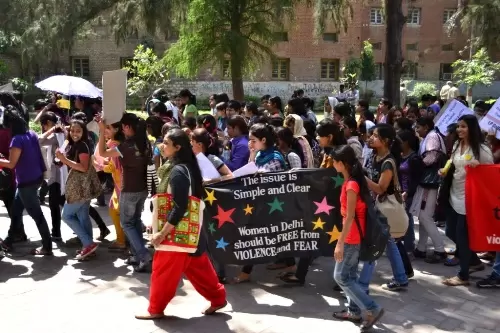Movement from rural to urban setting unleashes significant developments in woman’s life
22-December-2015
Vol 6 | Issue 51
Women in India have always been migrating. The only difference today is that they are not just moving post marriage or with their families anymore but are also stepping out of their homes and hamlets all by themselves to pursue an education or employment.
The negative aspects of such migration are well documented. It is known that women’s labour is often exploited; that there are low economic benefits in the jobs they do; and that the terms and conditions of such employment are not clearly laid down.
 |
|
A large number of girls in India today are migrating from small towns to metropolises for education (Photo: WFS)
|
But there is also a more positive aspect, which may not be very significant as far as proportions or numbers go, but is nevertheless important to highlight.
For instance, women are moving from small towns and even remote villages to metropolises like Delhi or Chennai, to study all kinds of courses. Once having adjusted to the urban milieu, and perceiving broader horizons, many among them are reluctant to go back to their places of residence and live as they once did.
They prefer to seek employment and pick out those social avenues that could entail a change of social perspective which, in turn, translates into different social outcomes - in the context of marriage, in the context of personal relationships, in the context of ways of life.
There are other developments too that are providing a fillip to migration. Take the crisis in the agricultural sector. On the one hand, the costs of input have risen exponentially; on the other, an array of factors from variable weather conditions to degradation of land have resulted in declining returns for the farmer.
This has seen men move out of agriculture in large numbers, leaving the women behind to tend to the farms and resulting in what we term as the feminisation of agricultural operations. Nowadays, women too are joining the men in such migration to urban areas.
In this context, a study I had done on women and migration, based on Census and National Sample Survey (NSS) data, was particularly interesting. The NSS data actually provides information as to how many women migrate and for what reason.
Obviously, it revealed that a large section of female migration can be attributed to marriage and only a very small proportion to work. While very few women report that they are going for work at the point of departure, a large number eventually does end up working.
This shows that, to some extent, migration is giving women the opportunity of entering the labour market and increasing their public participation in a manner that they themselves could not have originally envisaged.
If we look at women’s employment again from the statistical point of view, the largest segment within the regular women’s workforce, especially in urban areas, is in domestic work. This is a peculiar and particular kind of pattern as far as women’s work is concerned.
If one looks further at what this means for women, one comes across a very interesting scenario. Although a large number of studies view domestic work purely from the negative perspective in terms of lack of opportunities and rights, I tend to look at it more from the point of view of the potential for economic empowerment that domestic work offers to women.
The fact that these women are actually able to go out of their homes creates opportunities that they otherwise would not have had, given their lack of education or access to skill developing avenues. In other words, domestic work allows for an easy entry into the work market.
We would generally tend to look at such work, from the women’s status point of view, as something quite demeaning and which entails a loss of social status.
But once these women start earning money and contributing quite a substantial share to the household income, a new dynamic is set into motion. They then begin to be seen as contributors, both at the family level and within the social context in which they are located.
From the surveys we have undertaken in the ‘jhuggis’ (shanties) of Delhi, for instance, a large number of women did report that they had at first concealed from their husbands and other family members the fact that they were working as domestic help.
But some of them also reported how, subsequently, once the nature of their work came out into the open, it was generally appreciated. Women also talked about the demonstration effect they had on other women.
Some of these women were, in fact, in families that were going through immense economic hardships because of the poor avenues of employment that were available to the men and because the women themselves held the traditional view that leaving one’s home and working in somebody else’s would undermine their social status. Such notions were discarded once the benefits from domestic work came to be perceived.
Essentially, the very act of entry into the labour market enables a woman worker to interact with the world in a way she could not have done earlier. Even the perception of inequalities and injustices that mark her situation get clearer through this process, and some women are able to leverage their individual and collective strength to get a better deal for themselves.
In cities like Mumbai, one sees the emergence of fairly strong domestic workers’ unions. As workers, the women begin to realise what they had missed out on in life, perceive what is feasible, what is available and form their own ideas about how they and their families could do better for themselves.
For instance, these women tend to take specific and particular interest in educating their children, not just the boys but the girls, because they don’t want them to go through what they themselves had to experience. Such education ushers in generational change.
It is not uncommon to hear of a maid’s daughter scoring the highest marks in a board examination, or getting into jobs that would have been impossible to access a generation earlier. So, remarkable transformations are really possible.
The movement from a rural to an urban setting – no matter what the job at the other end is – unleashes many significant developments in a woman’s life. Most notably, it somewhat loosens the hold of social conventions and compulsions.
In rural India, the hierarchies of caste and religion, family traditions and norms, dictate everything from inter-personal relations to the broader social milieu. Given the deeply entrenched feudal social structures, one cannot do certain things even if one is educated and has very different perceptions about whom one would like to marry and what one would wish to do with one’s life. After all, even going with the husband to see a movie in a rural setting is sometimes difficult to envisage.
In a study undertaken in NOIDA, a city in the National Capital Region, a large number of women workers who had migrated from rural regions of Uttar Pradesh, Rajasthan, and Bihar actually said that they are now able to articulate many things they could not have done earlier – even with regard to tabooed subjects like their own sexuality.
Clearly, the urban milieu, with all its problems and frustrations, does entail a kind of freedom for the woman migrant. It provides her with some space to do things her way and imagine a new life for herself.
(The writer is Professor and Joint Director, Institute for Human Development (IHD), New Delhi, and has researched extensively into issues of gender and employment.) - Women's Feature Service















